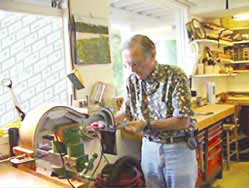 John Decker |
Decker earned a PhD in plasma physics in 1966. After receiving his PhD from Cambridge University, Decker worked as a research physicist for the Air Force, and then moved to the Sperry Rand Research Lab in Sudbury, Massachusetts, where his research focused on plasma stability. But just as he and his colleagues were celebrating the success of their project, they discovered that the effect they thought they had seen was an artifact of their apparatus. This effectively put an end to the entire area of research Decker had been working on.
He then worked at several other jobs, mostly in technical management, and even went into business for himself. In 1981, Decker moved out to Hawaii as manager of the Air Force’s optical observatory.
The idea for RainSong Graphite guitars came about in 1985, when Decker, an amateur classical guitarist himself, became frustrated with the damage that Hawaii’s extreme heat and humidity would do to an instrument.
He happened to attend an outdoor wedding reception, during which there was a sudden downpour. The shower caught the guitarist in a dilemma: should he run for cover, and risk angering the bride’s family, or keep playing, and buy a new guitar in the morning?
Sympathizing with the guitarist, Decker had a brainstorm: he would make a waterproof guitar.
He did what any good physicist would do: he sat down and wrote out equations describing the sound in a guitar.
The equations were familiar from his earlier work on acoustic waves in plasma. “Magneto-acoustic waves, like the sound waves in a guitar soundboard, are funny acoustic waves that have different properties in different directions,” he explains. In plasma, the direction is typically defined by the magnetic field; in the soundboard (top) of a guitar, the direction is typically defined by the grain direction of the wood. Properties such as acoustic velocity and stiffness are very different along and across the grain. “There’s no explicit magnetic field terms in the equations for a guitar, but the rest of it I recognized,” Decker says.
Setting out to imitate the qualities of a good spruce soundboard, Decker got data on the stiffness, density and other properties of wood, and figured out what composite materials would have similar properties. He quickly rejected most plastics (not stiff enough) and fiberglass (too heavy), before settling on “graphite” (a composite material of carbon fibers in an epoxy matrix).
Once they had some potential materials, they had to listen to the sound. A human ear, even an untrained one, can easily distinguish a high quality guitar or violin from a junk one, but no instrument can tell the two apart, says Decker. “I’m an instrumentation specialist. It’s what I’ve spent most of my career doing. And instrumentation is all but useless in making musical instruments. You can record a spectrum, you can record mode shapes on the soundboard surface, but it’s basically the same for junk stuff and high quality stuff.”
Decker also enlisted the help of a master guitar maker to show him how to make guitars himself. Decker’s approach to the guitars had been scientific, but “he insisted that I couldn’t just do it as a scientist or a businessman. I had to know how to make guitars with sawdust under my fingernails and lacquer in my hair,” says Decker.
Producing the graphite guitars posed a number of technological problems, which took about ten years to fully iron out. RainSong Graphite Guitars now sells about 700 guitars a year.
Although Decker’s original goal was to produce a weatherproof guitar, he realized that few people would buy an instrument solely for this property. “You sell them on the sound, pure and simple,” he says. And it turns out that graphite has a really good sound.
Compared to a traditional wood guitar, a graphite guitar sounds clearer and brighter, especially at high frequencies. Above about a kilohertz, wood is highly damping, meaning that vibrational energy goes into heat instead of audible sounds, so the guitar sounds “muddy,” Decker explains. “By the time you get to high harmonics on the high E string, what you hear is the attack, because the vibration of the top only lasts a few cycles, then damps out almost immediately.”
Graphite, on the other hand, is much less damping, giving a graphite guitar a clearer sound, he says.
Having successfully developed and marketed the graphite guitars, Decker has now retired, leaving the day-to-day operations of the business to his son-in-law. Decker still plays classical guitar, and, somewhat ironically, now makes classical wood guitars in his workshop, by hand. He says he is now hooked on the challenge of trying to make a wood guitar with some of the properties of the graphite ones.
–Courtesy of PhysicsCentral
©1995 - 2024, AMERICAN PHYSICAL SOCIETY
APS encourages the redistribution of the materials included in this newspaper provided that attribution to the source is noted and the materials are not truncated or changed.
Contributing Editor: Jennifer Ouellette
Staff Writer: Ernie Tretkoff
December 2006 (Volume 15, Number 11)
Articles in this Issue

